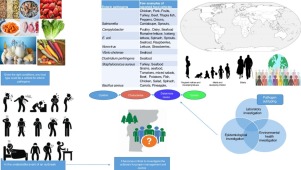Current Opinion in Food Science ( IF 8.9 ) Pub Date : 2020-03-07 , DOI: 10.1016/j.cofs.2020.02.007 Oluwadara O. Alegbeleye , Anderson S. Sant’Ana

|
There are numerous avenues for pathogenic contamination of produce along the cultivation, processing and retail chain, which presents major challenges for tracing the sources and routes of produce contamination. Over time, rapid, cost effective and flexible pathogen detection/subtyping methods that can yield ample diversity with portable data, have high discriminatory potential and possess a high level of epidemiological concordance have been developed and optimized. While this has not necessarily eliminated microbiological hazards, and produce-associated outbreaks continue to occur, sustained advancements in bacterial subtyping technologies together with better information technologies, have significantly improved the ability of regulators, public health laboratories and governments to identify food safety threats lurking in food supply chain(s). These evolutions and advancements have also dramatically improved the capacity of relevant authorities to identify and manage foodborne outbreaks. This overview explores contemporary pathogen subtyping approaches; PFGE, MLVA (the immediate previous gold standard for typing foodborne pathogens) together with WGS, the most recently adopted pathogen typing approach. Epidemiological findings illustrate that although PFGE can discern unique patterns in bacterial DNA, WGS is specific and can clarify inconclusive PFGE results. The quality and performance of pathogen subtyping is however, not sufficient and strong surveillance systems representative of all putative sources are required to identify the sources of human infection and adequately manage produce borne outbreaks and risks.
中文翻译:

病原体亚型化工具,用于风险评估和农产品生产暴发的管理
在种植,加工和零售链上,有许多途径可以对农产品进行致病性污染,这对于追踪农产品污染的来源和途径提出了重大挑战。随着时间的流逝,已经开发和优化了快速,经济高效且灵活的病原体检测/分型方法,该方法可以利用便携式数据产生足够的多样性,具有很高的歧视潜力,并具有很高的流行病学一致性。虽然这并不一定消除微生物危害,并且与农产品相关的暴发继续发生,但是细菌亚型技术的持续进步以及更好的信息技术已大大提高了监管机构,公共卫生实验室和政府识别潜伏在食品安全威胁中的能力。食品供应链。这些演变和进步也大大提高了有关当局查明和管理食源性疾病暴发的能力。本概述探讨了当代病原体分型方法;PFGE,MLVA(以前用于对食源性病原体进行分类的直接金标准)以及WGS(最近采用的病原体分类方法)。流行病学调查结果表明,尽管PFGE可以识别细菌DNA中的独特模式,但WGS是特异性的,可以阐明不确定的PFGE结果。但是,病原体分型的质量和性能还不够高,并且需要代表所有推定来源的强有力的监视系统来识别人类感染的来源并充分管理农产品引起的暴发和风险。










































 京公网安备 11010802027423号
京公网安备 11010802027423号